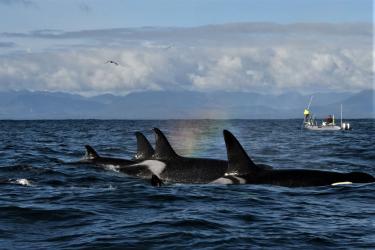NOAA Fisheries has released a draft List of Foreign Fisheries to characterize the scope of marine mammal bycatch in global commercial fisheries. The list—which includes the evaluation of 3,990 foreign fisheries that export fish and fish products to the United States—offers an unprecedented review of more than 135 nations’ regulatory programs addressing marine mammal bycatch in commercial fishing operations.
Marine mammals face an array of threats from human activities, including collisions with vessels, depletion of prey resources, pollution, disease, and habitat degradation and loss. Marine mammals are also at risk of bycatch in fishing gear—when fishermen catch species they don’t want or aren’t allowed to keep. Global data on marine mammal bycatch has been generally lacking, particularly species-specific data. For these reasons, marine mammals have presented an array of issues and challenges for conservation and management.
The creation of the first-ever comprehensive List of Foreign Fisheries is a key component in implementing the U.S. import provisions of the Marine Mammal Protection Act. Those provisions, published in 2016, required that nations exporting fish and fish products to the United States meet fishing standards for protecting marine mammals comparable in effectiveness to those followed by U.S. fishermen.
Working with U.S. trading partners over the past year, the NOAA Fisheries Office of International Affairs and Seafood Inspection compiled information on the number of fishery participants, number of vessels, gear type, target species, area of operation, fishing season, and any information regarding the frequency of marine mammal incidental mortality and serious injury, including programs to assess marine mammal populations or bycatch. In addition to identifying foreign commercial fisheries that export fish and fish products to the United States, the draft List of Foreign Fisheries also classifies those fisheries based on their documented or potential levels of marine mammal bycatch.
Together with documentation provided directly by exporting nations, NOAA Fisheries reviewed and considered, multiple sources of information, including:
-
The U.S. government seafood trade database of imported products.
-
Fishing vessel records.
-
Reports of on-board fishery observers.
-
Information from off-loading facilities, port-side government officials, enforcement, transshipment vessel workers, and fish importers.
-
Government vessel registries.
-
Regional fishery management organization or intergovernmental agreement documents, reports, national reports, and statistical documentation programs.
-
Appropriate catch certification programs.
-
Published literature and reports on commercial fishing operations with intentional or incidental mortality and serious injury of marine mammals.
Compiling and and evaluating this information was a comprehensive undertaking, not only to understand the scope of marine mammal bycatch, but also to characterize the efforts to mitigate it.
The long-term conservation impact of the MMPA import rule and the creation of the List of Foreign Fisheries demonstrate the potential impact of collaboration on marine mammal conservation on a global scale—a strong step forward in our efforts to achieve sustainable, resilient fisheries.



